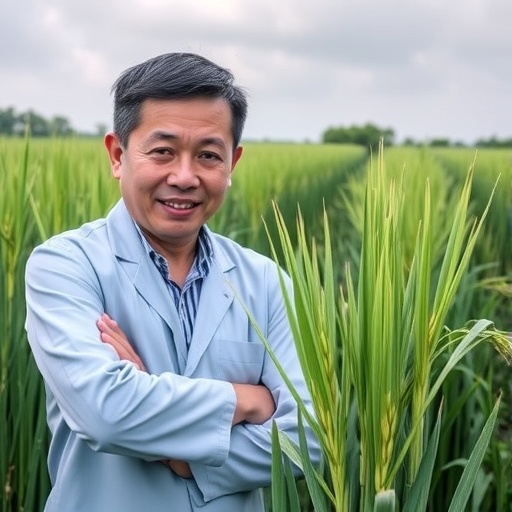A recent groundbreaking study conducted by Nie, Gu, and Li, along with their co-authors, has unveiled a significant advancement in our understanding of rice resistance to viral pathogens, specifically the Southern Rice Black-Streaked Dwarf Virus (SRBSDV). This research focuses on the gene OsJAR2, which is intimately linked with jasmonate biosynthesis. The findings, published in BMC Genomics, provide an in-depth analysis of how specific genetic factors can enhance resistance in rice, which is crucial for food security in regions where this crop is extensively cultivated.
Jasmonates are plant hormones that play a critical role in plant defense mechanisms against various biotic stresses. The study meticulously examines the pathway of jasmonate biosynthesis and how OsJAR2 modulates this process to bolster resistance against SRBSDV. The significance of this research extends beyond rice cultivation as it opens avenues for genetic engineering and breeding programs aimed at enhancing resilience in other crops susceptible to similar viral threats.
Through a comprehensive genome-wide association study (GWAS) and integrative multi-omics analysis, the researchers identified the interactions between OsJAR2 and various molecular pathways within rice plants. Their results indicate that enhanced jasmonate signaling leads to increased resistance against the virus by activating a series of defense-related genes. This mechanistic insight offers promising strategies for developing rice varieties with improved resilience against viral infections.
Rice, one of the most important staple foods for over half of the global population, faces numerous challenges due to viral diseases. Among them, SRBSDV poses a severe threat, causing significant yield losses and compromising food security. The capacity to uncouple the genetic underpinnings of resistance opens new doors for agricultural biotechnology, enabling the development of rice strains that can withstand such pathogens more effectively.
In the course of their study, Nie and his team utilized cutting-edge genomic techniques to map the roles of various candidate genes associated with jasmonate pathways. Their methodological approach included high-throughput sequencing and characterization of rice populations exposed to SRBSDV, allowing for a robust correlation between genetic markers and virus resistance traits. Such detailed analyses reveal the complex interplay between a plant’s genetic makeup and its environmental interactions, showcasing the power of modern genomic tools in agricultural research.
A pivotal aspect of their research centered around the functionality of the OsJAR2 gene. This gene encodes a protein involved in the synthesis of jasmonates, and its activity is crucial for triggering defense responses in plants. The findings suggest that variations in the OsJAR2 gene can influence the levels of jasmonate production, thereby modulating the strength of the plant’s immune response against viral invasion. This discovery urges further exploration of this gene’s potential in improving resistance mechanisms not just in rice, but also across other susceptible crops.
As viruses like SRBSDV continue to evolve and pose new challenges, it is imperative to investigate genetic strategies that can stay ahead of such threats. The study sheds light on the potential of utilizing the natural resistance mechanisms found within rice to breed more resilient strains through selective breeding and biotechnological interventions. The insights gained from this research could ultimately contribute to more sustainable agricultural practices, reducing reliance on chemical pesticides and fostering ecological balance.
The implications of this research extend beyond immediate agricultural applications. Understanding how jasmonate biosynthesis can enhance plant immunity opens pathways for creating plants that can adapt to various stressors—including climate change—thus securing food supplies in the face of increasing environmental challenges. Moreover, this paradigm shift towards harnessing natural plant defenses underscores the importance of incorporating genetic advancements into food production systems that are under constant threat from disease.
As researchers further investigate the role of the OsJAR2 gene and its relation to jasmonate biosynthesis, there is potential for developing gene-editing technologies such as CRISPR to create targeted mutations that can enhance resistance traits. Such innovations represent a significant step toward precision agriculture, allowing scientists and farmers to cultivate crops that not only meet yield expectations but also possess innate abilities to fend off pathogens effectively.
In conclusion, Nie and colleagues have marked a significant milestone in the fight against viral pathogens affecting rice crops. Their insightful findings related to the OsJAR2 gene and its connection to jasmonate-mediated resistance mechanisms provide a blueprint for future research and applications. With the looming threats of crop diseases exacerbated by climate change and shifting agricultural landscapes, this research underlines the importance of genetic innovation in safeguarding global food sources.
The intricate dance between plant genetics, environmental stressors, and pathogen interactions continues to intrigue scientists and agriculturalists alike. As we embrace these scientific advancements, the hope for a more resilient agricultural future rests on our ability to unlock the secrets of our crops’ genetic potential.
Through studies like those by Nie, Gu, and Li, we are reminded of the importance of collaboration in science and the intertwining of disciplines such as genomics, plant biology, and virology. The ability to connect the dots across fields is the essence of progress in understanding and overcoming the challenges faced by our food systems today.
In this ever-evolving landscape of agricultural science, the implications of research like this are profound. If applied thoughtfully, the discoveries surrounding jasmonate biosynthesis and viral resistance could lead to transformative changes in how we cultivate food crops, ultimately bolstering global food security.
Subject of Research: The role of OsJAR2 in jasmonate biosynthesis and its contribution to rice resistance against Southern rice black-streaked dwarf virus.
Article Title: GWAS and multi-omics study reveal OsJAR2 associated jasmonate biosynthesis contributes to Southern rice black-streaked dwarf virus resistance in rice.
Article References:
Nie, S., Gu, H., Li, Z. et al. GWAS and multi-omics study reveal OsJAR2 associated jasmonate biosynthesis contributes to Southern rice black-streaked dwarf virus resistance in rice. BMC Genomics 26, 971 (2025). https://doi.org/10.1186/s12864-025-12159-8
Image Credits: AI Generated
DOI: 10.1186/s12864-025-12159-8
Keywords: OsJAR2, jasmonate biosynthesis, rice, Southern rice black-streaked dwarf virus, GWAS, multi-omics, plant resistance, food security.




